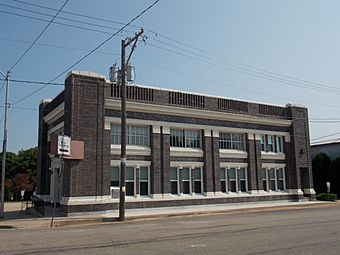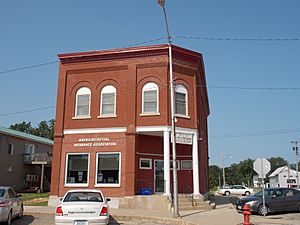Farmers and Merchants Savings Bank (Grand Mound, Iowa) facts for kids
Quick facts for kids |
|
|
Farmers and Merchants Savings Bank
|
|
 |
|
| Location | 601 Smith St. Grand Mound, Iowa |
|---|---|
| Area | less than one acre |
| Built | 1923 |
| Architect | Lytle Company |
| Architectural style | Late 19th century and Early 20th century revivals |
| NRHP reference No. | 01000909 |
| Added to NRHP | August 30, 2001 |
The Farmers and Merchants Savings Bank building is a cool old place in Grand Mound, Iowa, United States. It's also been known as the Union Savings Bank and First Trust and Savings Bank. This historic building was added to the National Register of Historic Places in 2001. This means it's an important landmark worth protecting.
Contents
A Look Back: The Bank's Story
The Farmers and Merchants Savings Bank first opened its doors in 1912. It was originally located in the Dugan's Saloon building. This building is just across the street from where the bank stands today.
The bank bought the land for its current building in 1919. The Lytle Company from Sioux City, Iowa designed the plans in 1921. The new bank building was constructed between 1922 and 1923. It was built on the most important business corner in Grand Mound. This was at Clinton and Smith Streets. The famous Lincoln Highway used to come into Grand Mound on Clinton Street. Then it would turn left at the bank onto Smith Street.
Grand Mound was started in 1858 by a railroad company. This was to help transport farm goods and provide services for the area's farming economy. In the late 1800s and early 1900s, farming grew a lot. This brought good times and wealth to the local community. However, the farming economy started to slow down in the early 1920s, right when the bank was built.
The bank ran into financial trouble in 1926. It was then sold to the Union Savings Bank of Grand Mound that same year. Over time, it became one of several smaller banks owned by the First Trust and Savings Bank of Wheatland, Iowa.
What Makes the Bank Building Special?
The Lytle Company was a construction company that also designed buildings. The exact person who designed this bank is not known. However, the Lytle Company had designed many other banks across Iowa and South Dakota.
A Mix of Old and New Styles
The bank building in Grand Mound mixes old-fashioned and modern design ideas. Its modern look came from a new way of thinking about banking. This was called "Progressive Banking." Back then, some people thought banks were unfair. Progressive Banking wanted to show that banks were good businesses. They wanted to help the community with their money needs. The building's design was meant to send this message. The bank building also stands out in Grand Mound. It is bigger and more decorated than other buildings in town.
Outside the Bank
What is now the First Trust and Savings Bank is a two-story building made of brick. It has off-white terra cotta (a type of baked clay) decorations. The corners of the building have large, strong-looking supports called pier-forms. These make the building look very solid and secure. These piers rise from a raised base. This base is covered with two colors of terra cotta. The top part is off-white, and the bottom part is gray.
The top edges of the building have a wide brick wall called a parapet. This parapet has a cool pattern. It looks like a fence with vertical bands that are slightly set back. There are also designs on the corner piers. The parapet is outlined with terra cotta stringcourses (decorative horizontal bands). The main entrances and window areas are set back into the wall. They are framed by flat, decorative columns called pilasters. The tops of these pilasters have a leaf-like design called a palmette.
Inside the Bank
Inside the bank, you can see marble teller windows. There is also a marble urn (a decorative vase) in the corner. The floor has a pattern of black and white tiles. The second floor of the building is not currently used. A dropped ceiling now covers the main public area on the first floor.




